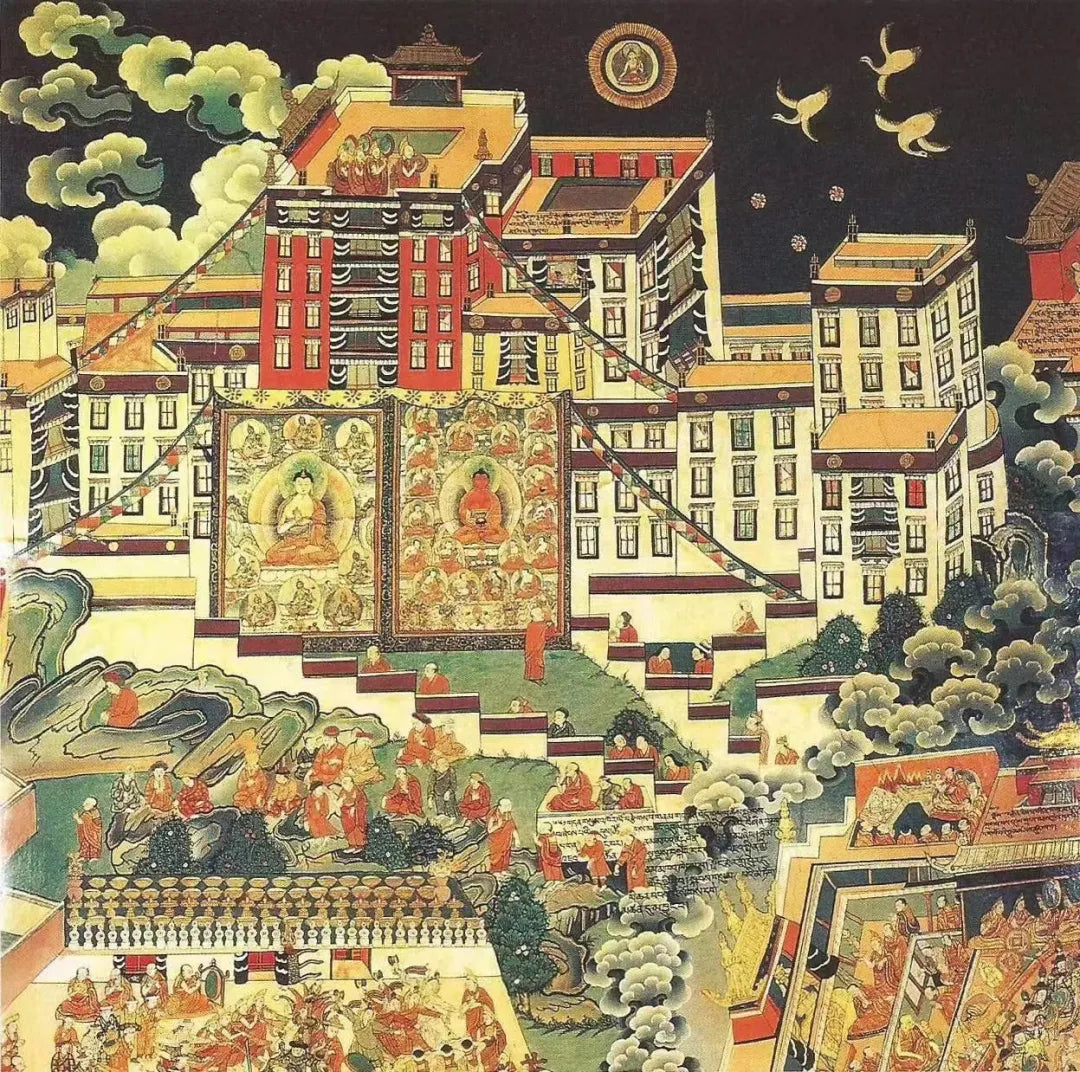
The forgotten classical grand event ▎ banquet for the procession of bright treasures

(1995, sourced from "Potala Palace")

(2022, from "Touring the Potala Palace")

(1995, from "The Potala Palace")

(1990s, painted by Ando Qiangba)
The highlight of the entire conference was the Lhoba Grand Procession held on the last day. Originally a dream of the Fifth Dalai Lama, it was brought to life by the Dalai Lama. The moment of the procession is intricately depicted in the murals of the Potala Palace.

(1995, from "The Potala Palace")
The entire image can be divided into two parts, with the Potala Palace as the core of the "Potala Palace and Snow Citadel" on the left, and the "Lhasa City" centered around the Jokhang Temple on the right. In the past, the administrative division of the entire Lhasa region could be divided into the main city area under the jurisdiction of the Lhasa Municipal Hall "Langzi Xia" and the Potala Palace and its citadel area under the jurisdiction of "Xueliekong" at the foot of the Potala Palace. These two areas were divided by the Lhasa River Bridge.


(1995, from "The Potala Palace")

(1995, from "The Potala Palace")
In some parts of the main city of Lhasa, the ceremony begins at the Jokhang Temple. When the morning sunlight illuminates the mountain peak of Gephel Wuzi in the west of the city, monks from local government-affiliated monasteries in Lhasa (such as Xide Temple, Xinmur Temple, and Yaowangshan Temple), the Upper and Lower Tantric Colleges, and the Three Great Monasteries (such as Drepung Monastery, Sera Monastery, and Ganden Monastery) start a procession in the courtyard of the Jokhang Temple, holding various ceremonial objects.

(1995, from "The Potala Palace")

The decorative symbol on the top of the pole represents the Five Buddhas. There are also over thirty people holding various implements such as the canopy, flags, banners, and conch shells. In addition, there are fifteen drummers and four pairs of musicians playing instruments to form a drumming ensemble. There are various bathing implements, mantras, sacrificial implements, and costumes depicting heavenly maidens, the Eight Auspicious Symbols, the Eight Auspicious Offerings, the Seven Treasures of the Chakravartin, and a dance troupe offering to the Buddha, totaling seven hundred and twenty-five people. Behind them, there is a second level with eight models of the Four Heavenly Kings towering one storey high.

banquet for the procession of bright treasures- Four Heavenly Kings model
(1995, from "The Potala Palace")

The grand procession circled around Barkhor Street before heading west, passing through Luilichiao and officially entering the core area of the Potala Palace Snow Guard City. This scene was also depicted in detail in the murals. Two giant Thangkas were displayed on the palace wall to the south of the Potala Palace, one centered around the five Buddhas on the left (རྒྱལ་བ་རིགས་ལྔ།), and the other around the boundless light Buddha on the right (སངས་རྒྱས་འོད་དཔག་མེད།).

(1995, from "The Potala Palace")

Colorful auspicious ribbons were hung around the Thangka, which are usually displayed on major holidays on both sides and the top center of buildings, resembling a colorful khata offered to the architecture.

In addition, the murals also depict the strange and wonderful scenery on the Potala Palace, with cranes swirling above the palace roof and flowers raining down from the heavens of the divine realm.






(1957, photographed by Chen Zonglie)




After the dance ended, the Oracle of Baihar, under the support of his attendants, entered the venue and paid respect to the great Buddha before starting to dance and deliver the oracle.



In front of the model is a dancer of Gyalrong Dance.


The honor guard walking out of the Snow Guards City
(Photographed by James Griffith in 1945)
Memories of first-hand witnesses
Zaxi Ciren, the national-level inheritor of intangible cultural heritage of Ga'er, served as a young dancer in the Potala Palace Dance Troupe from 1950 to 1959, participating in the offering of the Light Festival almost throughout the 1950s, playing a very important role in it.




Record of a Stranger in a Foreign Land
When Western explorers entered Tibet, they were naturally drawn to the grand procession of the Lingbo ceremony, and they used their cameras to capture the precious moments of the 20th century Lingbo procession.
The earliest recorded observer was the Russian ethnographer, Orientalist, and photographer Gombojab Tsybikov, who was the first to visit central Tibet in 1900-1901 and took the first photograph of the Lingbo procession. This photograph appeared in National Geographic magazine in 1905.

(1900-1901, photographed by Zybikov)

(1921, photo by Charles Bell)



